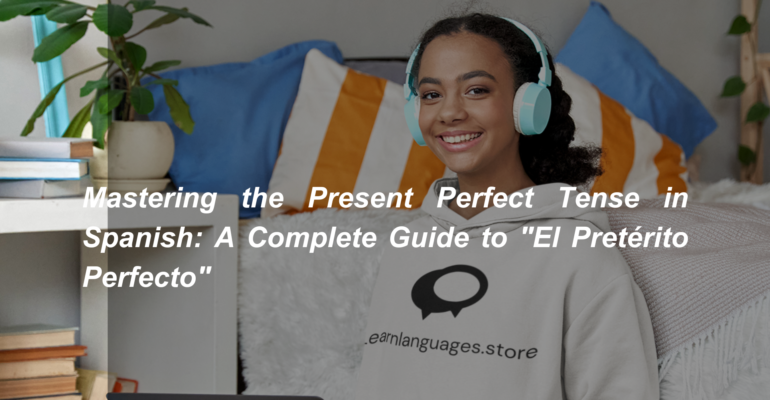Mastering the Present Perfect Tense in Spanish: A Complete Guide to “El Pretérito Perfecto”
Mastering the Present Perfect Tense in Spanish: A Complete Guide to “El Pretérito Perfecto”
Estimated reading time: 8 minutes
Learning Spanish can open doors to new cultures and opportunities, but the key to fluency lies in understanding its grammar patterns. One of the most important tenses in the language is the Present Perfect tense, known in Spanish as “El Pretérito Perfecto”. This tense allows speakers to express actions that have occurred recently or are relevant to the present moment. If you’re fluent in both Hindi and English, understanding how the Present Perfect tense works in Spanish will make your language journey smoother and more intuitive.
In this blog, we’ll dive deep into how to form and use the Present Perfect tense, break down its components, compare it with Hindi and English equivalents, and explore its exceptions. By the end, you’ll have a clear understanding of how this essential tense operates in Spanish, and you’ll be able to confidently apply it in conversations.

Introduction to the Present Perfect Tense (El Pretérito Perfecto)
The Present Perfect tense is used to talk about actions that started in the past but are connected to the present. In English, you might say, “I have eaten” or “She has traveled.” Similarly, in Spanish, you’d say, “He comido” (I have eaten) or “Ella ha viajado” (She has traveled).
The Present Perfect is formed by combining the present tense of the verb haber (to have) with the past participle of the main verb. The key function of this tense is to bridge the gap between past actions and their present relevance.
Unlike in Hindi, where past actions are often expressed without a perfect tense construction, or in English, where we explicitly use “have/has,” Spanish relies on a specific conjugation of haber followed by the past participle of the verb in question.
Forming the Present Perfect Tense in Spanish
The Present Perfect tense in Spanish is formed with two components:
- The present tense of the auxiliary verb haber (to have).
- The past participle of the main verb.
1. Conjugation of “Haber” in the Present Tense
| Pronoun | Haber (to have) |
|---|---|
| Yo | he |
| Tú | has |
| Él/Ella/Usted | ha |
| Nosotros/as | hemos |
| Vosotros/as | habéis |
| Ellos/Ellas/Ustedes | han |
2. Formation of the Past Participle
To form the past participle in Spanish:
- For -ar verbs, replace the -ar with -ado.
Example: Hablar (to speak) → Hablado (spoken) - For -er and -ir verbs, replace the -er or -ir with -ido.
Example: Comer (to eat) → Comido (eaten)
Example: Vivir (to live) → Vivido (lived)
Note: Some verbs have irregular past participles, which we will explore later in the blog.
Putting It All Together
To form a sentence in the Present Perfect tense, combine the conjugated form of haber with the past participle of the verb you want to use. For example:
- Yo he hablado – I have spoken.
- Tú has comido – You have eaten.
- Ellos han vivido – They have lived.
Usage of the Present Perfect Tense in Spanish
1. Actions Connected to the Present
The Present Perfect tense is used to describe actions that occurred in the past but are still relevant to the present moment. These are actions that might have just finished or have a lasting impact.
Example:
- He terminado mi trabajo. (I have finished my work.)
- Hindi: मैंने अपना काम खत्म किया है। (Maine apna kaam khatam kiya hai.)
In this case, although the action of finishing work happened in the past, the result is relevant to the current situation.
2. Life Experiences
In Spanish, the Present Perfect is often used to describe life experiences, much like in English.
Example:
- ¿Has viajado a España? (Have you traveled to Spain?)
- Hindi: क्या तुमने स्पेन की यात्रा की है? (Kya tumne Spain ki yatra ki hai?)
Here, the question refers to the general life experience of having traveled to Spain, not a specific moment.
3. Actions Happening Recently
The Present Perfect is also used to talk about actions that happened recently, particularly when the exact time isn’t specified.
Example:
- He comprado una casa. (I have bought a house.)
- Hindi: मैंने एक घर खरीदा है। (Maine ek ghar khareeda hai.)
Comparison with Hindi and English
1. English Equivalent:
In English, the Present Perfect tense is formed with “have” or “has” followed by the past participle. The usage is almost identical to Spanish in terms of talking about actions connected to the present or recent actions.
- English: I have eaten.
- Spanish: He comido.
- Hindi: मैंने खा लिया है। (Maine khaa liya hai.)
The sentence in all three languages expresses an action completed in the past but relevant to the present.
2. Hindi Equivalent:
Hindi, unlike Spanish and English, does not have a direct equivalent of the Present Perfect tense. Instead, Hindi uses simple past constructions with auxiliary verbs to convey the same meaning.
- Hindi: मैंने खा लिया है। (Maine khaa liya hai.)
Here, “है” (hai) acts as an auxiliary verb that connects the past action to the present.
Although the structure differs, the meaning conveyed is similar to that in Spanish and English.
Grammar Pattern Breakdown: Present Perfect Components
1. Auxiliary Verb: Haber
In the Present Perfect, haber is the auxiliary verb that plays the same role as “have” in English. It is always conjugated in the present tense.
2. Past Participle
The past participle is the unchanged form that follows the auxiliary verb. It does not change based on the subject of the sentence but is derived from the verb you want to use.
- -ar verbs → -ado (e.g., hablar → hablado)
- -er/ir verbs → -ido (e.g., comer → comido, vivir → vivido)
3. Word Order
In Spanish, the Present Perfect follows the pattern:
Subject + Haber (conjugated) + Past Participle.
For example:
- Yo he vivido en Madrid. (I have lived in Madrid.)
Hindi: मैं मैड्रिड में रहा हूँ। (Main Madrid mein raha hoon.)
This structure is consistent and does not change unless you’re forming questions or negatives.
Exceptions and Irregularities
While most verbs in Spanish follow the regular pattern of forming past participles with -ado or -ido, some verbs have irregular past participles that need to be memorized. Here are some common irregular past participles:
- Hacer (to do/make) → Hecho (done/made)
- Decir (to say) → Dicho (said)
- Escribir (to write) → Escrito (written)
- Ver (to see) → Visto (seen)
- Abrir (to open) → Abierto (opened)
- Poner (to put) → Puesto (put)
-
Product on sale
 French DELF B1
French DELF B1₹32,600.00
₹36,300.00
Example Sentences with Irregular Verbs:
- Spanish: He escrito una carta.
English: I have written a letter.
Hindi: मैंने एक पत्र लिखा है। (Maine ek patra likha hai.) - Spanish: Ellos han dicho la verdad.
English: They have told the truth.
Hindi: उन्होंने सच कहा है। (Unhone sach kaha hai.)
Example Sentences Using the Present Perfect Tense
Here are six example sentences with translations to English and Hindi:
- Spanish: Yo he comido.
English: I have eaten.
Hindi: मैंने खा लिया है। (Maine khaa liya hai.) - Spanish: ¿Has visto la película?
English: Have you seen the movie?
Hindi: क्या तुमने फिल्म देखी है? (Kya tumne film dekhi hai?) - Spanish: Nosotros hemos terminado el proyecto.
English: We have finished the project.
Hindi: हमने परियोजना समाप्त कर दी है। (Humne pariyojna samaapt kar di hai.) - Spanish: Ellos han viajado por Europa.
English: They have traveled through Europe.
Hindi: उन्होंने यूरोप की यात्रा की है। (Unhone Europe ki yatra ki hai.) - Spanish: Ella ha abierto la ventana.
English: She has opened the window.
Hindi: उसने खिड़की खोली है। (Usne khidki kholi hai.) - Spanish: Yo he vivido en México.
English: I have lived in Mexico.
Hindi: मैं मेक्सिको में रहा हूँ। (Main Mexico mein raha hoon.)
Frequently Asked Questions (FAQs)
Conclusion
Mastering the Present Perfect tense in Spanish will give you the ability to talk about past actions that still matter today. By comparing this tense with its English and Hindi equivalents, you can see how the structures work similarly across languages. Practice regularly with both regular and irregular verbs, and you’ll soon find yourself using the Present Perfect tense effortlessly in conversation. Keep practicing, and your fluency in Spanish will continue to improve!
Enhance Your Spanish Skills!
To improve your Spanish further, consider enrolling in our Spanish Course at Learn Languages Store for just Rs. 16,300. Our courses are designed to help you build a strong foundation in the Spanish language in a fun and engaging way.
Contact Us to Learn More!
For more information about our courses, feel free to reach out to us at:
Address:
330, 3rd Floor, Big Splash (Near Vashi Bus Depot),
Sector 17, Vashi,
Navi Mumbai, Maharashtra 400703
Phone: +91-9594113111
Email: services@learnlanguages.store
Don’t miss the opportunity to enhance your language skills! Sign up today and start your journey to fluency in Spanish!










